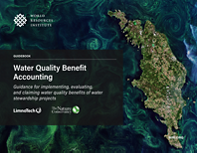Measuring Water Quality Benefits
A new tool helps companies calculate and communicate their water stewardship impact.

A shared challenge
With more than 2 billion people living in water-stressed regions, freshwater ecosystems aren’t just a resource; they’re crucial for sustaining the nature, communities and economies they flow through.
But these systems are facing growing pressure. Population growth, urbanization and industrial development are creating more wastewater than ever before, with increasingly concentrated levels of pollutants.
Along with industry, agricultural runoff can be a main contributor, carrying excess fertilizers and pesticides into groundwater and nearby waterways. These impacts are becoming more apparent throughout watersheds, making it clear that water quality must be considered along with quantity.
A new tool for measuring water quality benefits
To help companies better protect those systems, The Nature Conservancy, The World Resources Institute and LimnoTech have created the Water Quality Benefit Accounting (WQBA) Guide, a first-of-its-kind resource offering practical approaches for calculating water quality benefits across diverse landscapes, activity types and pollutant challenges.
The guide also provides information on important factors around project selection, tracking and reporting, and making claims, which are key considerations for companies looking to measure their contributions.
Why this project
Until recently, corporate water stewardship investments have focused on quantifying the volumetric water benefits of water stewardship activities to track progress. There is now an increased interest in improving watershed health and reporting on progress related to water quality as well as additional benefits, such as carbon reduction, ecosystem restoration and community well-being, associated with such activities.
Expanding the scope of corporate water stewardship
By moving beyond volumetric goals, WQBA provides a comprehensive approach to watershed health and supports more effective and inclusive freshwater strategies. This expanded accounting framework allows companies to pursue a wider range of water stewardship activities and to better communicate the value of their contributions to shared water challenges.
Download
-
 Water Quality Benefit Accounting Guide
Water Quality Benefit Accounting GuideA new tool to help companies calculate and measure their water stewardship impact.
Download